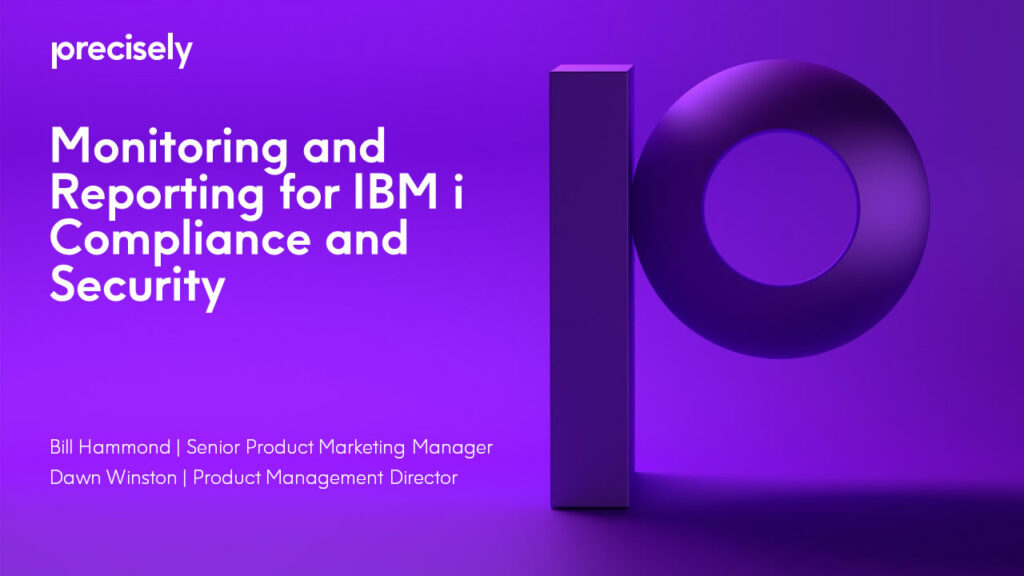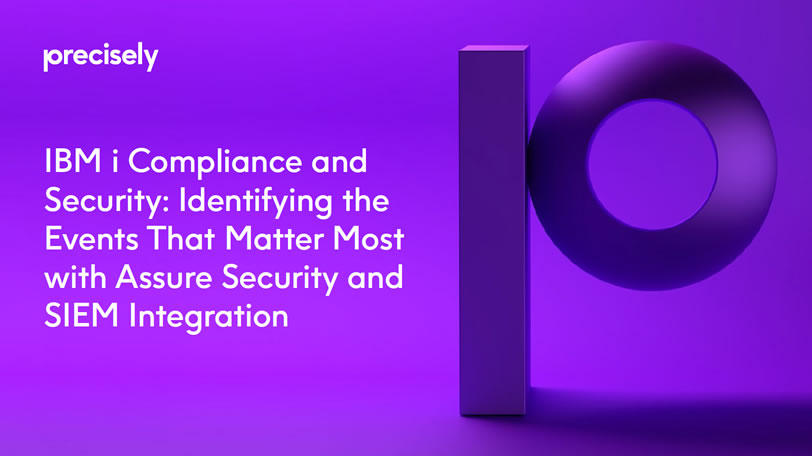
IBM i SOLUTIONSIBM i monitoring and reporting solutions
Dealing with today’s increasingly stringent regulations and evolving security threats requires a proactive approach that includes monitoring, reporting, and integrating IBM i security.
Comprehensive monitoring of IBM i security
IBM i journals and log files contain a wealth of system and application activity details that are vital not only for monitoring and managing security, but also for proving regulatory compliance and conducting post-event forensic analyses. But there are so many logs tracking such a huge number of events and, on top of that, in their native format, those logs are notoriously cryptic and extremely difficult to understand. Without a way to capture, organize, and filter all that data quickly and reliably, it is nearly impossible to gain useful security insights or to create useable audit reports in a timely manner.
Further complicating matters, regulations such as GDPR require that organizations also monitor and be prepared to report on user views of highly confidential data – regardless of whether the users have made changes. However, the fact is that data regarding user views of healthcare records, financial records, and protected consumer information are not kept in any IBM i journals or logs.
As a result, you need to have third-party solutions in place to monitor and log views of particularly sensitive data and to enable timely alerts and useable reporting on those events, right along with all the other IBM i security activity.

Automating security alerts and reporting
To demonstrate compliance with regulatory requirements as well as your own organization’s internal security policies, you need to have full visibility into a wide variety of system and application events. Such events include:
- Changes to system values
- User profile activities
- Authentication failures
- Access attempts through the network or command lines
- Data encryption and decryption
- The transfer of sensitive data across the network
- and much more
Taken together, IBM i log sources, including the journals and message queues maintained by the OS, embody a comprehensive audit trail of changes. Among the most valuable and informative log sources provided are:
- The System Audit Journal (QAUDJRN) – contains information related to events that impact security, such as changes to system values, object authorities, profiles, authorization lists, object access attempts, and more.
- Operator Messages (QSYSOPR Message Queue) – contains alerts that inform the operator about a condition that needs attention or about changes to the environment.
- System and Application Messages (QSYSMSG Message Queue) – an optional message queue that issues alerts about high priority system events. It should be created and monitored continuously.
- QHST History Log – message queue and several physical files that contain a list of messages that reflect specific events occurring on IBM i systems.
These four key log sources provide the most essential, core records required to effectively monitor for security and compliance deviations, as well as to generate alerts and reports on all types of security activity.
However, reading and understanding the records contained in these vital logs in their native format is nearly impossible. To stay compliant and continuously monitor the security of your IBM i systems, you need a solution that enables you to quickly identify and alert on important events and critical conditions without significant effort – or a major programming project.
Beyond that, given the huge volume of data present in those logs, the additional challenge is to avoid the situation where your new monitoring and reporting solution seriously impacts overall system performance by adding a huge additional CPU workload and adding consuming amounts of DASD. Your chosen solution must be able to efficiently filter and extract only the truly pertinent data from all those logs and streams of real-time monitoring data that are needed to support your goals.
Assure Monitoring and Reporting from Precisely automates the capture and analysis of IBM i log sources to save you time and money when monitoring for regulatory compliance and detecting threats to systems and data security.

CUSTOMER STORYCampbell County Wyoming
See how Precisely’s journal audit reporting solution brought Campbell County, Wyoming IT staff unexpected benefits.
Monitoring and blocking views of sensitive data
Regulations such as PCI DSS and HIPAA have long suggested the benefits of tracking access to confidential data. More recently, consumer privacy regulations like GDPR have begun to require it, and new regulations are likely to follow that lead.
For example, if a staff member at a bank views highly confidential financial information which they are not authorized to see, the bank may be liable for the costs and consequences of a data breach, even if the individual claims they didn’t read the data. And customer data is not the only sensitive data that must be carefully protected. You must also ensure that unauthorized users are not viewing confidential information such as corporate financial data, employment and compensation records, employee medical data, or customer lists.
Logs are required to prove to internal and external auditors that such data has not been viewed without authorization. However, IBM i journals and history files do not monitor or log views of data – only changes to data. In order to prevent both accidental data disclosures and intentional breaches of confidentiality, you need a solution that monitors and logs views of sensitive data.
Third-party tools are available that can integrate with and leverage IBM i system processes in order to identify and capture views of sensitive Db2 data and to alert you to users who have seen sensitive records – along with how and when the data was viewed. Some of these tools can even block records from being viewed by unauthorized users.
The most effective data view monitoring solutions will allow you to define detailed rules regarding not only what records can be seen by which user, but also to give you full control over the conditions under which those users can view the records. For example, views may only be allowed on weekdays, during certain hours, or when using a particular program. It is also critical that these solutions generate logs to satisfy the requirements of compliance auditors.
Assure Db2 Data Monitor from Precisely enables full and reliable control over confidential and sensitive data, for regulatory compliance as well as internal oversight.

EBOOKPassing Your Next Audit
The Challenges of Properly Securing Your IBM i and Maintaining Compliance
Learn more about IBM i security challenges commonly faced by staff at IBM i shops in their efforts to harden security and pass compliance audits.
Integrating IBM i security data into SIEM solutions
Security Information and Event Management (SIEM) solutions are essential for ensuring IT security in many organizations today. SIEM technology aggregates data produced by security devices, network infrastructure, systems, and applications, and combines it with contextual information about users, assets, threats, and vulnerabilities to enable real-time security monitoring and alerting. In addition, SIEM solutions are available that include next-generation analytics capabilities, to not only detect and alert, but to actively predict vulnerabilities.
But the most valuable benefit of SIEM solutions is the comprehensive, enterprise-wide integration and coordination of security systems and processes. Every business today is dependent on multiple interconnected applications and networks that span on-premises and cloud-hosted systems, networks and and storage. It has simply become impossible to maintain security effectively by managing each system and network separately when data must be moved and shared constantly and fluidly between applications and systems. And given the growing sophistication and complexity of today’s advanced cyber threats, any security vulnerability in any one system essentially exposes all other systems and data.
Your IBM i systems are no exception. No matter how fully and stringently you manage IBM i security, doing so separately introduces both increased risk and unnecessary cost and inefficiency, both for your IBM i platform and across the rest of your organizations business systems.
If your business has invested in SIEM technology, or is considering doing so, it is vital to integrate your IBM i security information into the solution in order to enable early detection and threat response across all enterprise systems. Unfortunately, integrating security information from IBM i systems into an enterprise SIEM platform is a challenge due to the wide range of IBM i log sources which need to be to monitored, their proprietary data formats, and the specialized skills required to analyze and integrate that data.
Once again, third-party solutions are required in order to bridge the gap. When evaluating and choosing solutions for integrating IBM i security data, in addition to automating the analysis of IBM i log sources and generating reports and alerts within your IBM i systems, at a minimum you also need to be able to export your IBM i security data for inclusion in other enterprise security analysis and reporting applications. To fully integrate IBM i security information, your chosen solution must also be able to forward that data in real time to SIEM systems such as IBM QRadar, Solar Winds, Splunk, ArcSight, LogRhythm, LogPoint, Netwrix, and others for integrated, real time analysis with security data from other platforms.
To learn more about fully integrating IBM i security information into your SIEM solution, download our eBook IBM i Compliance and Security: Identifying the Events That Matter Most.



